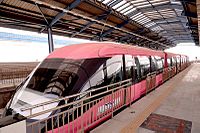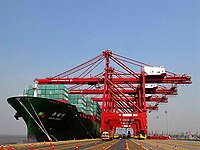Mumbai ( formerly known as Bombay) is the capital city of the Indian state of Maharashtra. It is the most populous city in India with an estimated city proper population of 12.4 million as of 2011. Along with the neighbouring regions of the Mumbai Metropolitan Region, it is the second most populous metropolitan area in India, with a population of 21.3 million as of 2016. Mumbai lies on the Konkan coast on the west coast of India and has a deep natural harbour. In 2008, Mumbai was named an alpha world city.[18] It is also the wealthiest city in India, and has the highest number of millionaires and billionaires among all cities in India. Mumbai is home to three UNESCO World Heritage Sites: the Elephanta Caves, Chhatrapati Shivaji Maharaj Terminus, and the city's distinctive ensemble of Victorian and Art Deco buildings.
The seven islands that constitute Mumbai were originally home to communities of Koli people, who originated in Gujaratin prehistoric times. For centuries, the islands were under the control of successive indigenous empires before being ceded to the Portuguese Empire and subsequently to the East India Company when in 1661 Charles II of Englandmarried Catherine of Braganza and as part of her dowry Charles received the ports of Tangier and Seven Islands of Bombay. During the mid-18th century, Bombay was reshaped by the Hornby Vellard project, which undertook reclamation of the area between the seven islands from the sea.[28] Along with construction of major roads and railways, the reclamation project, completed in 1845, transformed Bombay into a major seaport on the Arabian Sea. Bombay in the 19th century was characterised by economic and educational development. During the early 20th century it became a strong base for the Indian independence movement. Upon India's independence in 1947 the city was incorporated into Bombay State. In 1960, following the Samyukta Maharashtra Movement, a new state of Maharashtra was created with Bombay as the capital.
Mumbai is the financial, commercial and entertainment capital of India. It is also one of the world's top ten centres of commerce in terms of global financial flow, generating 6.16% of India's GDP and accounting for 25% of industrial output, 70% of maritime trade in India (Mumbai Port Trust and JNPT), and 70% of capital transactions to India's economy. The city houses important financial institutions such as the Reserve Bank of India, the Bombay Stock Exchange, the National Stock Exchange of India, the SEBI and the corporate headquarters of numerous Indian companies and multinational corporations. It is also home to some of India's premier scientific and nuclear institutes like Bhabha Atomic Research Centre, Nuclear Power Corporation of India, Indian Rare Earths, Tata Institute of Fundamental Research, Atomic Energy Regulatory Board, Atomic Energy Commission of India, and the Department of Atomic Energy. The city also houses India's Hindi (Bollywood) and Marathi cinema industries. Mumbai's business opportunities, as well as its potential to offer a higher standard of living, attract migrants from all over India, making the city a melting pot of many communities and cultures.
Transport
Public transport
Public transport systems in Mumbai include the Mumbai Suburban Railway, Monorail, Metro, Brihanmumbai Electric Supply and Transport(BEST) buses, black-and-yellow meter taxis, auto rickshaws and ferries. Suburban railway and BEST bus services together accounted for about 88% of the passenger traffic in 2008. Auto rickshaws are allowed to operate only in the suburban areas of Mumbai, while taxis are allowed to operate throughout Mumbai, but generally operate in South Mumbai. Taxis and rickshaws in Mumbai are required by law to run on compressed natural gas (CNG), and are a convenient, economical, and easily available means of transport.
Rail
The Mumbai Suburban Railway, popularly referred to as Locals forms the backbone of the city's transport system. It is operated by the Central Railway and Western Railway zones of the Indian Railways. Mumbai's suburban rail systems carried a total of 6.3 million passengers every day in 2007. Trains are overcrowded during peak hours, with nine-car trains of rated capacity 1,700 passengers, actually carrying around 4,500 passengers at peak hours. The Mumbai rail network is spread at an expanse of 319 route kilometres. 191 rakes (train-sets) of 9 car and 12 car composition are utilised to run a total of 2,226 train services in the city.
The Mumbai Monorail and Mumbai Metro have been built and are being extended in phases to relieve overcrowding on the existing network. The Monorail opened in early February 2014. The first line of the Mumbai Metro opened in early June 2014.
Mumbai is the headquarters of two zones of the Indian Railways: the Central Railway (CR) headquartered at Chhatrapati Shivaji Terminus(formerly Victoria Terminus), and the Western Railway (WR) headquartered at Churchgate. Mumbai is also well connected to most parts of India by the Indian Railways. Long-distance trains originate from Chhatrapati Shivaji Terminus, Dadar, Lokmanya Tilak Terminus, Mumbai Central, Bandra Terminus, Andheri and Borivali.
Bus
Mumbai's bus services carried over 5.5 million passengers per day in 2008, which dropped to 2.8 million in 2015. Public buses run by BEST cover almost all parts of the metropolis, as well as parts of Navi Mumbai, Mira-Bhayandar and Thane. The BEST operates a total of 4,608 buses with CCTV cameras installed, ferrying 4.5 million passengers daily over 390 routes. Its fleet consists of single-decker, double-decker, vestibule, low-floor, disabled-friendly, air-conditioned and Euro III compliant diesel and compressed natural gas powered buses. BEST introduced air-conditioned buses in 1998. BEST buses are red in colour, based originally on the Routemaster buses of London. Maharashtra State Road Transport Corporation (MSRTC, also known as ST) buses provide intercity transport connecting Mumbai with other towns and cities of Maharashtra and nearby states. The Navi Mumbai Municipal Transport (NMMT) and Thane Municipal Transport (TMT) also operate their buses in Mumbai, connecting various nodes of Navi Mumbai and Thane to parts of Mumbai.
Buses are generally favoured for commuting short to medium distances, while train fares are more economical for longer distance commutes.
The Mumbai Darshan is a tourist bus service which explores numerous tourist attractions in Mumbai. Bus Rapid Transit System (BRTS) lanes have been planned throughout Mumbai. Though 88% of the city's commuters travel by public transport, Mumbai still continues to struggle with traffic congestion.[247] Mumbai's transport system has been categorised as one of the most congested in the world.[248]
Water
Water transport in Mumbai consists of ferries, hovercrafts and catamarans. Services are provided by both government agencies as well as private partners. Hovercraft services plied briefly in the late 1990s between the Gateway of India and CBD Belapur in Navi Mumbai. They were subsequently scrapped due to lack of adequate infrastructure.[250]
Road
Mumbai is served by National Highway 3, National Highway 4, National Highway 8, National Highway 17 and National Highway 222 of India's National Highways system. The Mumbai-Pune Expressway was the first expressway built in India. The Eastern Freeway was opened in 2013. The Mumbai Nashik Expressway, Mumbai-Vadodara Expressway, are under construction. The Bandra-Worli Sea Link bridge, along with Mahim Causeway, links the island city to the western suburbs. The three major road arteries of the city are the Eastern Express Highway from Sion to Thane, the Sion Panvel Expressway from Sion to Panvel and the Western Express Highway from Bandra to Dahisar.Mumbai has approximately 1,900 km (1,181 mi) of roads. There are five tolled entry points to the city by road.
Mumbai had about 721,000 private vehicles as of March 2014, 56,459 black and yellow taxis as of 2005, and 106,000 auto rickshaws, as of May 2013.
Air
The Chhatrapati Shivaji International Airport (formerly Sahar International Airport) is the main aviation hub in the city and the second busiest airport in India in terms of passenger traffic. It handled 36.6 million passengers and 694,300 tonnes of cargo during FY 2014–2015. An upgrade plan was initiated in 2006, targeted at increasing the capacity of the airport to handle up to 40 million passengers annually and the new terminal T2 was opened in February 2014.
The proposed Navi Mumbai International Airport to be built in the Kopra-Panvel area has been sanctioned by the Indian Government and will help relieve the increasing traffic burden on the existing airport.
The Juhu Aerodrome was India's first airport, and now hosts the Bombay Flying Club and a heliport operated by state-owned Pawan Hans.
Sea
Mumbai is served by two major ports, Mumbai Port Trust and Jawaharlal Nehru Port Trust, which lies just across the creek in Navi Mumbai.Mumbai Port has one of the best natural harbours in the world, and has extensive wet and dry dock accommodation facilities.[268] Jawaharlal Nehru Port, commissioned on 26 May 1989, is the busiest and most modern major port in India.[269] It handles 55–60% of the country's total containerised cargo.[270] Ferries from Ferry Wharf in Mazagaon allow access to islands near the city.[271]
The city is also the headquarters of the Western Naval Command, and also an important base for the Indian Navy





























No comments:
Post a Comment